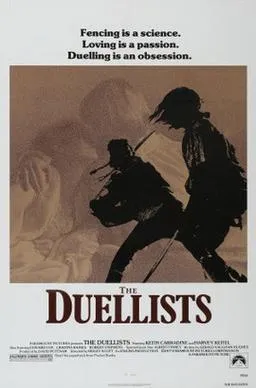Historical accuracy of The Duellists

Historical accuracy of The Duellists

Characters
Armand d'Hubert
Based on a character in Joseph Conrad's story, which was inspired by the real Pierre Dupont de l'Étang. The portrayal captures elements of a Napoleonic officer but is ultimately a fictionalized interpretation.
Gabriel Feraud
Based on a character in Conrad's story, inspired by the real François Fournier-Sarlovèze. The portrayal reflects the fiery temperament attributed to Fournier but is filtered through Conrad's narrative and the film's script.
Laura
A fictional character created for the film to illustrate d'Hubert's personal life and the consequences of the feud.
Adèle
A fictional character representing d'Hubert's desire for peace and domesticity after the wars.
Joseph Fouché
Based on the real, powerful historical figure Joseph Fouché, Napoleon's Minister of Police. His brief appearance reflects his role in the post-Napoleonic political purges.
General Treillard
Represents the military hierarchy of the time. While likely not based on a specific, single general, the role and function within the army structure are historically plausible.
More characters
Chevalier
Represents the necessary role of seconds in duels. Not based on a specific known individual but reflects a real function within duelling culture.
Madame de Lionne
Represents the social settings of the era where officers might mingle. Likely a fictional character serving a specific plot function (the location of the initial perceived insult).
Story
Based on Conrad's "The Duel" / Real feud
The film's core premise of a decades-long feud between two officers is directly based on the real historical duel between Dupont and Fournier-Sarlovèze, as fictionalized by Conrad.
Initial quarrel over delivering arrest notice
The specific incident sparking the feud (delivering an unwelcome order leading to a challenge) mirrors the reported origin of the real-life Dupont-Fournier duel.
Feud spans decades of Napoleonic Wars (c.1800-1816)
The film accurately sets the protracted duel against the backdrop of the Napoleonic Wars, reflecting the lengthy timeframe of the historical feud.
Multiple duels fought with various weapons
While the real feud involved numerous encounters (~30), the film depicts a smaller, representative selection using various weapons (sabers, epees, pistols). The spirit is true, but the specifics are condensed/composited.
Dueling despite being officially discouraged
The film accurately shows dueling occurring between officers despite it often being officially prohibited or frowned upon by military command.
Pause in dueling due to differing ranks
Accurately reflects the period's duelling code where challenges were generally only valid between equals in rank, necessitating pauses in the feud as promotions occurred.
Encounter during the Retreat from Moscow (1812)
The Retreat from Moscow is a real event. The specific encounter and temporary alliance against Cossacks follows Conrad's fictional narrative set within this historical context.
Political divide (Bonapartist vs. Royalist leanings)
Effectively uses the characters' differing loyalties (Feraud the Bonapartist, d'Hubert the adaptable aristocrat) to reflect the real political turbulence of the Napoleonic and Restoration eras.
d'Hubert saves Feraud from post-Napoleonic purge
This event follows Conrad's narrative, highlighting d'Hubert's character and the irony of the feud within the real political context of the Bourbon Restoration purges.
Final duel with pistols
The resolution of the feud via a pistol duel aligns with accounts of how the real Dupont-Fournier conflict ended, as interpreted by Conrad.
d'Hubert spares Feraud but "kills" his honor
This specific outcome – sparing the opponent's life while ending the feud by denying him the right to issue further challenges – is derived from Conrad's fictional interpretation of the final encounter.
Obsession with honor driving the conflict
Accurately portrays the powerful, sometimes irrational, code of personal honor that could motivate such extreme and prolonged conflicts among officers in this historical period.
Setting
Napoleonic Era Europe (France, Germany, Russia)
Filmed primarily on location, the settings convincingly evoke the various European landscapes relevant to the Napoleonic campaigns experienced by the characters.
Napoleonic Military Uniforms (Hussars)
The film is highly regarded for its meticulous research and accurate depiction of French Hussar uniforms, showing variations appropriate to the specific regiments and time periods covered.
Weaponry (Sabers, Epees, Pistols)
Accurately represents the types of swords (cavalry sabers, smallswords/epees) and flintlock duelling pistols characteristic of the Napoleonic era officer class.
Dueling Culture and Etiquette
Realistically portrays the rituals associated with dueling, including the use of seconds, the formality, and the underlying code of honor that governed such encounters.
Visual Style (Inspired by paintings)
Ridley Scott's deliberate use of natural light and compositions mimicking Napoleonic-era paintings contributes significantly to the film's authentic period atmosphere.
Military Life / Barracks / Campaign Settings
Provides authentic glimpses into the conditions of military life for cavalry officers, including time in barracks, on campaign (like the Russian winter), and the general military environment.
Civilian Settings (Salons, Estates)
Effectively contrasts military settings with civilian environments appropriate to the characters' social standings, such as aristocratic salons and country estates during periods of peace or leave.
